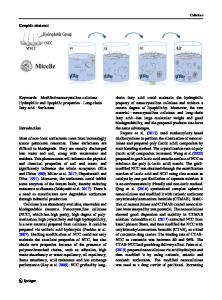Surface Modification of Nanocrystalline Cellulose toward a Tunable Optical Polarizer
- PDF / 575,186 Bytes
- 7 Pages / 432 x 648 pts Page_size
- 44 Downloads / 244 Views
MRS Advances © 2015 Materials Research Society DOI: 10.1557/adv.2015.45
Surface Modification of Nanocrystalline Cellulose toward a Tunable Optical Polarizer Martin Bolduc1, Michel Poirier1, Gregory Chauve2, Hassane Oulachgar1, Tom Tiwald3, Pierre Laperle1, David Gay1, Patrick Beaupre1, Myriam Methot2, Melanie Leclerc1, Sebastien Deshaies1, Martin Briand1, Jean Bouchard2, and Pierre Galarneau1 1 INO - Institut National d'Optique, 2740 Einstein, Québec City, QC, G1P 4S4 Canada 2 FPInnovation, 570, Blvd Saint-Jean, Pointe-Claire, QC, H9R 3J9 Canada 3 J.A. Woollam Co., Inc., 645 M Street, Lincoln, NE, 68508 USA ABSTRACT Nanocrystalline cellulose (NCC) solid films obtained from evaporated aqueous heterogeneous mixtures retain the self-assembled chiral nematic order formed in the suspension. These semi-translucent films are iridescent and reflect or transmit circularly polarized visible light (400-700nm) due to the chiral properties of the self-assembled nanostructure. This effect occurs at different wavelengths depending on the pitch of the helical structure. In this paper, NCC films have been fabricated from different recipes to produce various helix pitches. The corresponding red-shift in the optical wavelength has been obtained by means of Spectrophotometry measurements. Preliminary experiments have been performed to investigate optical polarization effects as function of angles of incidence using ellipsometry. Finally, laser micromachining results on NCC films may suggest feasibility for integration as tunable light polarizer components. INTRODUCTION The NCC is extracted from native cellulose sources by controlled sulfuric acid hydrolysis. Specifically, wood cellulose nanocrystals average 100-200nm in length with a crosssection of 3-5nm. The use of sulfuric acid to produce NCC imparts negatively charged acidic sulfate ester groups to NCC surfaces, resulting in electrostatically stabilized aqueous suspension [1-3]. Such suspension separates into upper random and lower ordered phases at NCC concentrations above a critical value. The ordered phase is a chiral nematic liquid crystal with NCCs arranged in pseudo-planes as depicted in Figure 1. [4-6]
Figure 1. Schematic illustration of the isotropic (left) and chiral nematic phases (right) of a NCC suspension at equilibrium. The half-pitch P/2 is also shown (taken from [5]). Aqueous NCC suspensions can be dried out to produce solid semi-translucent NCC films that retain the chiral nematic order of the liquid crystalline phase [6]. The chiral nematic pitch shrinks as the suspension evaporates to dryness, which depends on suspension properties and film formation conditions. The average NCC axis direction in each plane is rotated at a small angle, producing a helical arrangement. The pitch P of the helix is defined as the distance
651
Downloaded from https://www.cambridge.org/core. Columbia University Libraries, on 12 Aug 2019 at 18:19:03, subject to the Cambridge Core terms of use, available at https://www.cambridge.org/core/terms. https://doi.org/10.1557/adv.2015.45
Data Loading...










